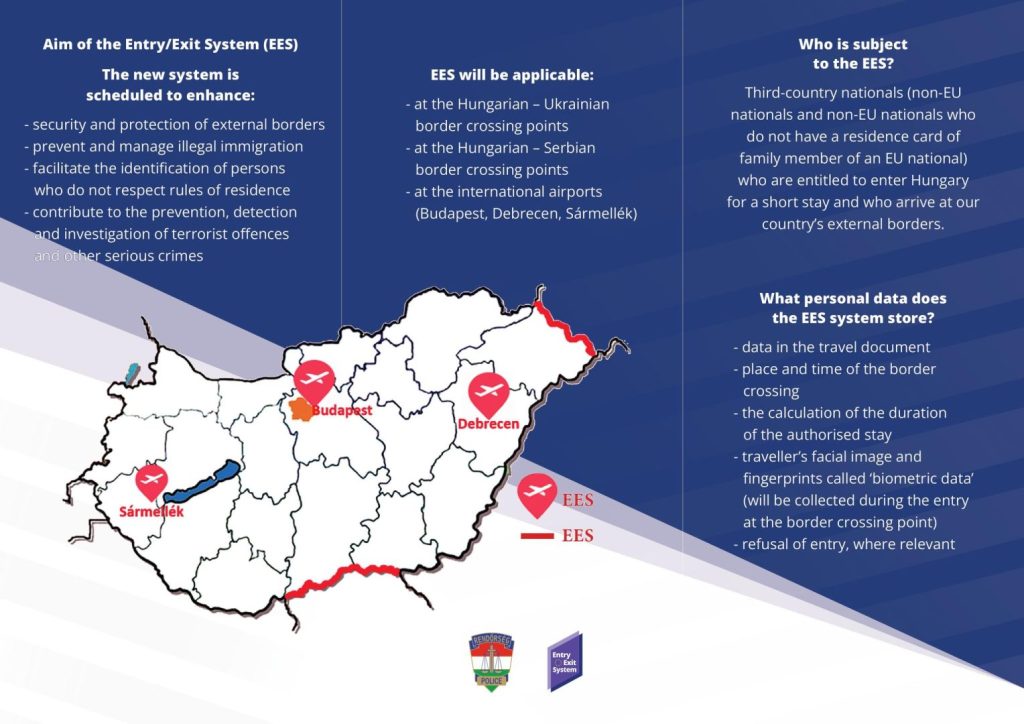Sunday Morning: New Borders, Familiar Confusion
It’s Sunday morning, and the new EU Entry/Exit System (EES) officially begins. I just came back from Rome yesterday, and even there, you couldn’t miss it – posters, screens, and warnings everywhere across Europe. This weekend’s flights felt like the calm before a very digital storm.
Honestly, Andrew and I don’t travel much outside the Schengen Zone these days, so we won’t be among the first to experience it. Still, I’m curious to hear people’s stories as the rollout begins – especially those of Brits now living here in Hungary with post-Brexit residency rights. They’ll likely encounter the most confusion at first, caught between “visitor” systems and “resident” status.
And as anyone who’s ever queued at a border knows, the combination of new tech and bureaucracy rarely equals efficiency – at least not on Day One.
What Is the EU Entry/Exit System?
The EU Entry/Exit System (EES) replaces traditional passport stamping with biometric registration – fingerprints and a facial photo – for non-EU citizens entering or leaving the Schengen area for short stays.
The idea is to tighten security, prevent overstays, and automate the 90-days-in-180 rule that border guards used to calculate manually. It’s a shared database across all Schengen countries – including Hungary, Norway, Iceland, Liechtenstein, and Switzerland – that records every entry and exit automatically.
The system officially launched across the EU on 12 October 2025. Hungary has started gradually, introducing EES first at land border crossings, beginning with Beregsurány on the Ukrainian frontier. Serbia will follow shortly after, while Budapest Liszt Ferenc International Airport is scheduled to switch to the new system on 18 November.
In the meantime, travellers may encounter both old and new systems running side by side. Yes, that means you might get a passport stamp and a biometric scan – bureaucracy loves a safety net.
Who Needs to Register?
If you’re a non-EU citizen visiting the Schengen area (for example, from the UK, US, or Canada), you’ll need to register the first time you cross an external Schengen border. This involves:
- Presenting your passport as usual.
- Providing fingerprints and a photo, either at a staffed booth or a self-service terminal.
- Waiting – Politico reports that queues may triple at major airports and land crossings during the first few weeks.
Once enrolled, your biometric data remains valid for three years, or five if your exit isn’t properly recorded (say, if you depart via a smaller crossing).
The good news? There’s no cost and no pre-registration required. You don’t need to sign up in advance or download an app – just show up, smile for the camera, and press your fingers on the scanner.
Who Is Exempt from the EU Entry/Exit System in Hungary?
If you live in Hungary – meaning you hold a valid residence permit or long-stay visa – you’re exempt. That includes:
- Residents with a Hungarian residence card (Lakcímkártya and residence permit).
- Citizens of EU or EEA countries.
- UK nationals covered under the Withdrawal Agreement (post-Brexit settlement status).
Still, you should always travel with your residence card and passport, as exemptions rely on proof of your residency status at the border. If your permit has expired or you only have a temporary card, expect questions – or a longer line.

Visual guide to Hungary’s rollout of the EU Entry/Exit System (EES), showing where biometric border checks will apply at airports and land crossings from October 2025.
Hungary’s Gradual Rollout: Expect Delays
Hungary isn’t alone in taking it slow. As of launch day, only Estonia, Luxembourg, and the Czech Republic are applying EES fully to all passengers. Most EU countries, including Hungary, are staggering the implementation through early 2026.
According to 444.hu, Hungarian border guards will record biometric data manually in some locations while the technology is fine-tuned. Expect longer processing times at major crossings like Röszke (Serbia) or Záhony (Ukraine).
The European Commission has said it may temporarily suspend EES during the transition if waiting times or technical failures become excessive. In other words: this is very much a work in progress.
If you’re travelling in or out of Hungary in the next few weeks, allow extra time – especially if your trip connects to non-Schengen destinations like the UK or Türkiye.
What the EU Entry/Exit System Means in Practice
For most residents, nothing changes. Your residence card and passport remain your key travel documents, and EES will not affect internal Schengen travel (e.g. Budapest–Rome).
For visitors, though, the shift is significant. The system removes human discretion – your allowed stay will now be calculated by computer, and overstays will be instantly flagged across all EU borders. That’s useful for security but less forgiving for genuine mistakes.
It also means that short-term visitors – family members, contractors, or dual-citizens-in-progress – should keep an eye on entry and exit dates more carefully than before.
For a country like Hungary, which borders several non-Schengen neighbours, EES could make border crossings slower in the short term but more predictable in the long run.
Helpful Resources & Links
- Official EES information (European Commission): https://travel-europe.europa.eu/ees
- European Commission guidance for UK citizens (Withdrawal Agreement): https://bit.ly/4q46HBf
- Hungarian news coverage: 444.hu EES report (Hungarian)
- Internal link: Hungary Driver’s Licence 2025: What It Costs – another piece of bureaucracy decoded.
FAQ
Do I need to register for the EU Entry/Exit System before travelling to Hungary?
No. Registration happens automatically when you enter the Schengen area from outside. You’ll provide fingerprints and a photo at the border, either with a border guard or via a self-service kiosk.
Does the EES apply to UK citizens living in Hungary?
If you hold valid residency under the post-Brexit Withdrawal Agreement, you’re exempt. However, carry your residence permit to prove it, especially during the transition period.
How long will my biometric data be stored?
For three years, or up to five if your exit isn’t recorded. After that, the data is automatically deleted unless renewed by a new entry.
In the Bigger Picture
Today marks another small but symbolic shift in how Europe manages mobility – from stamps and stories to scanners and stored data. For those of us who remember the satisfying thunk of a passport stamp, it feels a little clinical, but undeniably modern.
I’ll be watching closely to see how Hungary handles its rollout, especially once Budapest Airport joins in November. For now, I’m just glad to be home, coffee in hand, unpacked from Rome, and ready for a quieter week – ideally one without queues.
Join Me LIVE in Budapest (22 October)
If you’re in Budapest later this month, don’t miss our next HOW TO HUNGARY LIVE event at KLUSTER– a deep dive into Hungary’s healthcare system, with real experts, live demos, and a few surprises.
In one evening, you’ll gain:
• A practical overview of the public healthcare system: how it works, who’s eligible, and what the TAJ card really provides.
• Guidance on finding a doctor in the public system and using the national health app for appointments, prescriptions, and records.
• Expert insight into private care – from annual plans at international clinics to full insurance coverage.
• A candid comparison of public vs. private hospitals and what to expect in each.
• A curated takeaway guide with official links, contacts, and practical next steps.
🩺 Special Guest Feature: AI Mole Mapping & Live Checks
We’re thrilled to welcome Dr. Mintas, dermatologist, who will demonstrate how AI is transforming mole mapping and skin cancer prevention in Hungary. She’ll even offer quick on-the-spot checks for attendees who want peace of mind.
🎤 Featuring:
• Eszter Balázs — 4theClients, Healthcare Insurance Expert
• Liam Crow — FirstMed Budapest, Private English-Speaking Clinic
• Hosted by me, Anikó Woods, founder of HOW TO HUNGARY
This event is for internationals in Hungary who want clarity and confidence in their healthcare options – whether you’re new to the system, exploring private coverage, or simply checking that your setup still works for you.
👉 Click here to RSVP or learn more

Anikó Woods is a Canadian-Hungarian writer, technology specialist, and digital strategist who swapped Toronto traffic for Hungarian bureaucracy. She’s the creator of HOW TO HUNGARY: Budapest & Beyond. Since moving to Hungary in 2017, she’s been deep in the paperwork trenches – fact-checking, interviewing experts, and helping others make sense of the madness. Her writing turns chaos into clarity, with a few laughs (and wine recommendations) along the way.

0 Comments